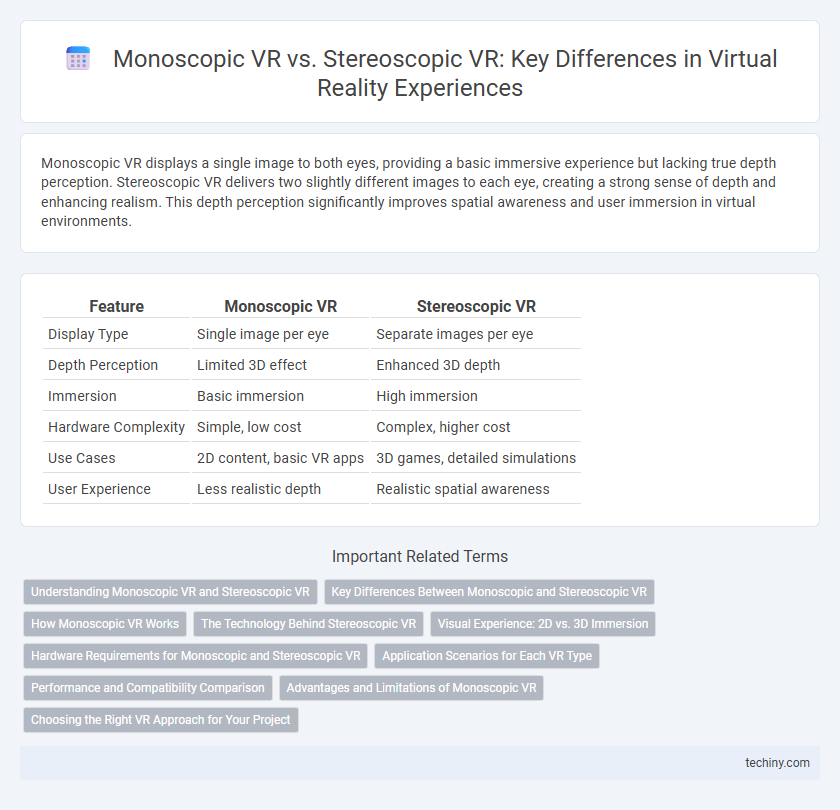Monoscopic VR displays a single image to both eyes, providing a basic immersive experience but lacking true depth perception. Stereoscopic VR delivers two slightly different images to each eye, creating a strong sense of depth and enhancing realism. This depth perception significantly improves spatial awareness and user immersion in virtual environments.
Table of Comparison
| Feature | Monoscopic VR | Stereoscopic VR |
|---|---|---|
| Display Type | Single image per eye | Separate images per eye |
| Depth Perception | Limited 3D effect | Enhanced 3D depth |
| Immersion | Basic immersion | High immersion |
| Hardware Complexity | Simple, low cost | Complex, higher cost |
| Use Cases | 2D content, basic VR apps | 3D games, detailed simulations |
| User Experience | Less realistic depth | Realistic spatial awareness |
Understanding Monoscopic VR and Stereoscopic VR
Monoscopic VR presents the virtual environment using a single image for both eyes, resulting in a flat, two-dimensional perception with no depth cues. Stereoscopic VR delivers separate images to each eye, simulating binocular vision and creating a realistic three-dimensional effect with enhanced depth perception. This fundamental difference impacts user immersion and the overall virtual experience, making stereoscopic VR more effective for applications requiring spatial awareness.
Key Differences Between Monoscopic and Stereoscopic VR
Monoscopic VR displays a single image to both eyes, resulting in a flat, less immersive experience ideal for simpler applications. Stereoscopic VR provides two slightly different images to each eye, creating depth perception and a more realistic 3D environment essential for advanced simulations and gaming. The key differences lie in visual depth cues, immersion levels, and hardware complexity, with stereoscopic systems requiring more processing power and sophisticated display technology.
How Monoscopic VR Works
Monoscopic VR displays a single flat image to both eyes, creating a uniform visual experience without depth perception. It uses one camera or rendering viewpoint, which simplifies hardware requirements and reduces processing power compared to stereoscopic VR. This approach is commonly found in basic VR headsets and mobile VR applications where cost-efficiency and compatibility are prioritized.
The Technology Behind Stereoscopic VR
Stereoscopic VR utilizes dual lenses and two slightly offset images to create depth perception, mimicking the way human eyes naturally view the world. This technology employs precise eye tracking and advanced rendering algorithms to deliver immersive 3D visuals with accurate spatial cues. Compared to monoscopic VR, stereoscopic systems enhance realism by providing binocular disparity, essential for a convincing sense of presence in virtual environments.
Visual Experience: 2D vs. 3D Immersion
Monoscopic VR provides a 2D visual experience where both eyes see the same flat image, limiting depth perception and spatial awareness. Stereoscopic VR delivers a 3D immersive experience by presenting slightly different images to each eye, creating a realistic sense of depth and enhancing spatial immersion. This depth simulation significantly improves user engagement and realism in virtual environments.
Hardware Requirements for Monoscopic and Stereoscopic VR
Monoscopic VR requires less demanding hardware, typically needing only a single camera feed or rendering pipeline, which reduces GPU load and allows for smoother performance on lower-end systems. Stereoscopic VR demands dual rendering for each eye, effectively doubling the graphical workload and necessitating powerful GPUs and high-refresh-rate displays to maintain immersive and lag-free experiences. Hardware specifications for stereoscopic VR include advanced GPUs, higher bandwidth connectivity, and more precise motion tracking sensors compared to monoscopic setups.
Application Scenarios for Each VR Type
Monoscopic VR is commonly used in applications like virtual tours, real estate walkthroughs, and simple training simulations where depth perception is less critical. Stereoscopic VR excels in gaming, medical simulations, and immersive architectural visualization by providing a realistic sense of depth and spatial awareness. Each VR type optimizes user experience based on the need for depth accuracy and interaction complexity in various application scenarios.
Performance and Compatibility Comparison
Monoscopic VR renders a single image per eye, resulting in lower computational demands and broader compatibility with less powerful hardware, making it ideal for basic VR experiences. Stereoscopic VR generates two slightly different images for each eye, enhancing depth perception and immersion but requiring significantly higher GPU performance and more advanced display capabilities. Compatibility for stereoscopic VR is limited to devices that support dual-image rendering and precise head-tracking, whereas monoscopic VR can run on a wider range of VR headsets and mobile platforms.
Advantages and Limitations of Monoscopic VR
Monoscopic VR offers the advantage of lower computational requirements and simpler hardware, making it more accessible and cost-effective for users and developers. It allows for easier content creation since it uses a single viewpoint, reducing complexity, but this also limits depth perception and immersion compared to stereoscopic VR's dual viewpoints. The lack of true 3D spatial cues in monoscopic VR can result in a less realistic experience and potential difficulty in accurately judging distances within the virtual environment.
Choosing the Right VR Approach for Your Project
Monoscopic VR delivers a single image to both eyes, offering a simpler and more cost-effective solution suitable for basic immersive experiences or 360-degree video viewing. Stereoscopic VR provides two slightly different images to each eye, creating a depth perception crucial for high-fidelity simulations, gaming, and training applications. Selecting the right VR approach depends on your project's fidelity requirements, hardware capabilities, and the level of immersion needed to engage users effectively.
Monoscopic VR vs Stereoscopic VR Infographic

 techiny.com
techiny.com